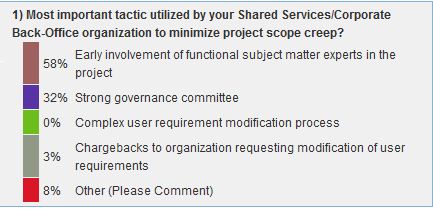Project Management in Shared Services – Managing Scope Creep
As Shared Services organizations expand and take on more complex implementations, as well as the ongoing evolution of the enterprise business model, the need for project management techniques as a core skill is critical as more and more functional areas and operational locations are impacted.
Some Shared Services organizations have a formal Project Management Office (“PMO”) staffed with appropriately skilled folks to manage large and complex projects, while others either up-skill managers responsible for projects or supplement the team with project managers from another area within the organization. Regardless of where the project management is sourced from, one of the issues that can plague any project is scope creep. Learning how to manage scope creep, and related stakeholder expectations can go a long way in bringing in a project on time, on budget, and with expected results.
In a recent poll, Peeriosity members indicated that both early involvement and strong governance were the most important tactics to use to manage scope creep.
We then followed up by asking how effective Shared Services organizations were at minimizing scope creep and, while 24% indicated a high rate of effectiveness in preventing scope creep, 76% reported that there was room for improvement.
On a recent Peeriosity member webcast, our feature company shared their methodology to “Better Manage User Expectations and Scope Creep”. For every project managed within their Shared Services organization, they follow a methodology that encompasses the project’s scope, requirements, and risk. Each has a formal plan.
Within their scope management is where the formal project plan is maintained and the challenges with requests for enhancements, as well as changes that arise from insufficiently defined user requirements are addressed. Planning includes a formal Project Charter that incorporates among other things;
- Objectives
- Cost-Benefit Analysis (and who is accountable for costs and benefits delivery)
- Scope of Project – Defined Deliverables
- Participants – their roles and authority
- Assumptions and Restrictions
- Timeline and Milestone Report Dates
- Stakeholder Acceptance Criteria (For each stakeholder)
- Measurements
One of the items discussed in some detail was how to avoid confusion on the scope between what is planned by the project team and what is expected by the customer, creating what can be called a “surprise” gap. One of the tools displayed on the webcast was what our presenting company calls an “Is / Is Not” Template that explains in plain language what each deliverable actually is and, maybe more importantly, what it is not. This template is completed very early in the project with all stakeholders agreeing to their respective deliverables.
Active scope management means always being aware of the one-off changes that can quickly add up and derail project costs and the project timeline, as well as negatively impact other planned deliverables. Strict procedures must be followed for ANY change in the plan, with formal sign-offs and accountabilities that include full impact analysis and communication to all stakeholders.
The webcast went on to further discuss project tracking requirements. The group discussed how to best capture all of the implications associated with the project as it relates to operations and, most importantly, their customers, technical impact (e.g. impact on operating system response time, ongoing maintenance, and licensing costs), and functional impact (e.g. usability for end-user and changes to their role, training needed).
The webcast ended with a discussion on risk management and then how to actually ensure that risk management skills are within the Shared Services organization or at least readily available for projects either led by Shared Services or which have large implications for Shared Services
This webcast, like all Peeriosity webcasts, is archived online and available for members at their convenience, along with all related documents for download.
How is your company managing projects, scope creep, and stakeholder expectations?
Who are your peers and how are you collaborating with them?



